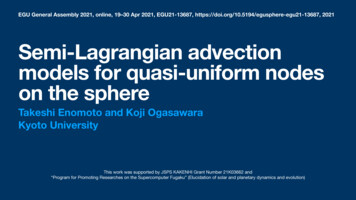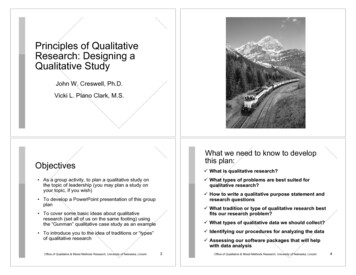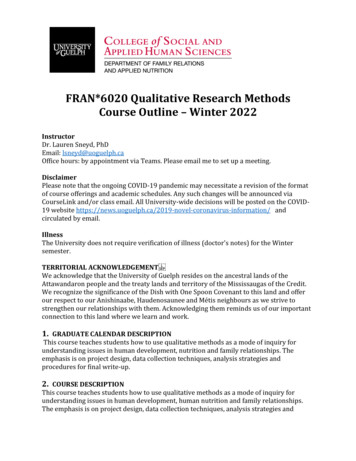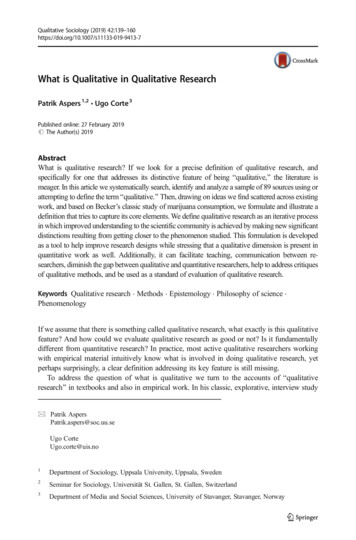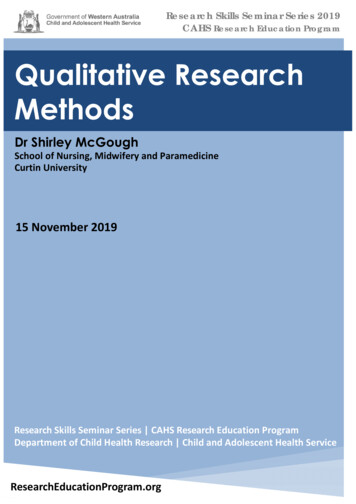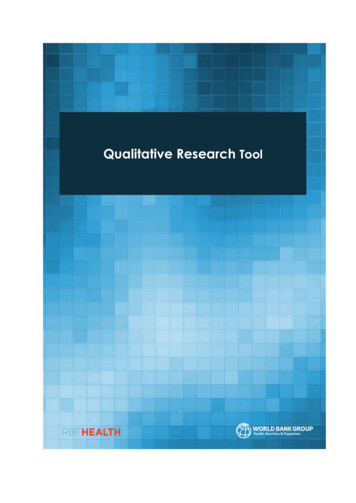
Transcription
Qualitative Research Tool
1
This training guidance document was adapted, by Fabian Cataldo and M Kent Ransonfrom the following qualitative methods manual:Chandler, C.I.R., Reynolds, J., Palmer, J.J., & Hutchinson, E. (2013) ACT ConsortiumGuidance: Qualitative Methods for International Health Intervention Research. Availableat www.actconsortium.org/qualitativemethodsguidance2
INTRODUCTION TO THIS DOCUMENTThis qualitative research guidance note is intended to provide a practical and reader-friendly guideto conducting qualitative research in the context of impact evaluations of RBF programs. Ultimately,this guidance note will be integrated into (or presented alongside) the RBF impact evaluation valuation-toolkit).The targeted audience is impact evaluation teams consisting of TTLs, practitioners, principalinvestigators (PI), government representatives and local and international researchers involved inthe evaluations.Early in the process of developing this guidance note, we (staff of the Health Results Innovation TrustFund secretariat) came across the online resources developed by Clare Chandler and colleagues forthe ACT Consortium ion-research). It was readily apparent that these guidance notes andrelated materials were well suited to our needs. We found that the tools and SOPs could be easilymodified – for example, we used the in-depth interview and focus group discussion topic guides forour work in Rwanda. We subsequently engaged Dr. Chandler and team to: (i) review of thequalitative research conducted within RBF programs (RBF) under the HRITF; and (ii) based on thisreview, to identify RBF examples and resources that could be included in the toolkit, in place ofmalaria-specific examples. This guidance note is the result. Readers will find that some malariaspecific examples remain – this is the case when RBF examples could not be identified. It isanticipated that this guidance note will be updated over time, and that additional RBF examples willbe incorporated as the body of qualitative research on RBF interventions increases.How to use this documentThis guidance document covers theory and practical advice on qualitative methods in five chapters.Chapter 1 introduces the reader to some of the principles of social science that underlies qualitativeresearch and three key stages of intervention design and evaluation which qualitative methods cancontribute to. This chapter is suitable for readers who are interested in the theoretical foundation ofqualitative research. Those who are not ready to engage in fieldwork may find this a sufficientintroduction. Those who already have some understanding of the theoretical underpinnings, butwho are ready to design their own study, may be interested in jumping on the subsequent chapters.Chapter 2 discusses principles and practices for using three core qualitative research methods.Chapter 3 covers some practical issues relating to setting up a qualitative research project alongsideor imbedded within an intervention.While this entire document is devoted to improving the quality of qualitative research ininterventions, in Chapter 4, specific theory and methods for assuring on-going quality in qualitativeresearch are discussed.Finally, approaches to analysis and writing-up of qualitative data in a team are discussed in Chapter5.Annex 1 describes the thorough review of all qualitative studies that was conducted to inform thistoolkit. In presents the approach, findings, and recommendations from a desk-based review of the3
qualitative research conducted within Results-Based Financing programmes (RBF) under the HealthResults Innovations Trust Fund (HRITF).Qualitative research and social science theory terms which may be new to readers are highlighted inblue in the text; their definitions can be found in the Glossary at the beginning of this document.Throughout the document we refer to specific experiences from planning and conducting qualitativeresearch in ACT Consortium interventions. We also refer to examples of materials developed for thiswork and include extracts from these as boxes, tables and figures. The reader can find many moreexamples from ACT Consortium qualitative research, however, in the Supplementary Materialsdeveloped for and referred to highlighted in orange in this guide, available on the ACT Consortiumwebsite. These include:1. ACTc Qualitative Research Protocol Template and Tools2. ACTc Quality Assurance Monitoring for Qualitative Research Protocol Template3. ACTc Qualitative Research Training materials (a folder including workshop Powerpointpresentations and handouts)4
Table of Contents. 2INTRODUCTION TO THIS DOCUMENT. 3Table of Contents . 5Abbreviations . 8Glossary . 9CHAPTER 1 Introduction to Qualitative Research. 131.1 Why Do Qualitative Research? 131.2 Social Science Principles Informing Qualitative Research 141.3 Who Does Qualitative Research?151.4 Qualitative Contributions to Intervention Research1.5 Formative Field Research16171.5.1Honing understanding of the research problem and potential solutions 171.5.2Use of conceptual frameworks 181.5.3Participatory research for intervention content 211.6 Process Evaluation221.6.1Components and logic of process evaluation1.6.2Process evaluation methods1.6.3Use of process evaluation results1.7 Outcome Evaluation222526261.7.1Components and logic of outcome evaluation1.7.2Outcome evaluation methods 281.7.3Use of outcome evaluation results2631CHAPTER 2 Qualitative Fieldwork Methods. 332.1 In-Depth Interviews342.1.1Sampling342.1.2Development of field work instruments 362.1.3Piloting 382.1.4Preparation for field work2.1.5Collecting the data392.1.6Managing the data412.1.7Data analysis412.2 Focus Group Discussions538422.2.1Sampling422.2.2Development of field work instruments 432.2.3Piloting 46
2.2.4Preparation for field work2.2.5Collecting the data472.2.6Managing the data482.2.7Data analysis2.3 Direct Observations4648492.3.1Sampling502.3.2Development of field work instruments 502.3.3Piloting 522.3.4Preparation for field work2.3.5Collecting the data522.3.6Managing the data532.3.7Data analysis52532.4 Transcription & 3Translation57542.5 Analytic Approach- theory that governs the methods you will choose2.5.1Thematic content analysis612.5.2Grounded Theory Approach6360CHAPTER 3 Setting up the Research Project . 643.1 Choosing a Good Team 643.2 Training Team Members653.3 Drafting a Protocol & Standard Operating Procedures3.4 Ethical Issues in Qualitative Research6566CHAPTER 4 Running a Good Quality Project . 684.1 Ongoing Quality Assurance684.1.1Defining quality assurance for qualitative research4.1.2Quality assurance approach4.1.3Defining principles of good practice694.1.4Plan of activities to assure quality694.1.5Responsibility for quality assurance714.2 Monitoring Qualitative Research686971CHAPTER 5 Interpreting Qualitative Data . 735.1 Coding & Analysis of Qualitative Data6735.1.1An overview of the analytic process5.1.2Using computer software5.1.3The coding procedure 755.1.4Coding in a team807573
5.1.5Moving from descriptive to analytic coding5.2 Writing up Qualitative Data5.3 Synthesizing Findings8183835.3.1Secondary Analysis5.3.2Synthesis8485REFERENCES . 887
AbbreviationsFGDsFocus group discussionsHFsHealth facilitiesHWsHealth workersIDIsIn-depth interviewsSOPStandard Operating ProcedureRDTRapid diagnostic testQASQuality assessment and strengthening8
GlossaryGlossaryAnalytic approachA theoretical orientation to and set of techniques for conceptualisingand interpreting data.CodingThe practice of categorising data (e.g., sections of text from transcripts)by meanings or ideas, as they are interpreted by a researcher.Conceptual frameworkA theoretical framework or model describing the priorconceptualisation taken by a researcher of a particular phenomenon orissue. Often depicted graphically, a conceptual framework identifiesfactors that researchers believe may explain or influence the ‘problem’to be studied, outlining hypothesised relationships between them.Constructivism(ist)An epistemological approach, or school of thought, which sees reality asmultiply constructed, similar to interpretivism. But, whereasinterpretivist researchers typically maintain analytic distance betweentheir own and research subjects’ beliefs as a matter of credibility,constructivist researchers recognise the shared or co-construction ofmeanings and explanations by both researchers and participants andmay treat research activities as opportunities for change.EpistemologyEpistemology is concerned with ways of knowing and learning aboutthe world. Different epistemologies reflect different accepted ways thatknowledge can and should be acquired. These epistemological positionsreflect different ways of thinking about the nature of reality (ontology).In social research, some research is based on the premise that there is asocial world which can be objectively observed and described in termsof sets of rules or laws, in a similar way to the natural sciences(positivism). Some other research is based on the premise that there isno single reality, there are multiple realities that are constructed bydifferent groups, and learning about social worlds is an exercise inrelativity and reflection on the position of the researcher in generatingknowledge (constructivism).EthnographyA methodological approach to research that originated in the disciplineof anthropology and aims to understand peoples’ social worlds throughimmersion in their communities, using long term participantobservation together with other methods such as interviews, often withthe same individuals over time, and surveys informed by theethnographer’s observations. The product of this work is richdescriptions of the daily lives, relations, priorities and principles ofdifferent groups. The word ‘ethnography’ is also used to describe thisproduct – usually in book form.Field notesA primary method of data collection in ethnographic research, fieldnotes or diaries are a reflexive tool that researchers can use to recordmany types of informally-collected data. They are particularly used as atool for participant observation where researchers seek to write ‘thickdescriptions’ of what they are observing. Such unstructured notes allowthe fieldworker to record what they are seeing, hearing and thinking,which may not be captured in structured methods or recordings. Such
Glossarynotes may include drawings of spaces, dynamics of a situation or theencounter with the researcher, connections made with previousobservations or ideas and new ideas for inclusion in later fieldwork.Formative researchAims to understand an existing situation into which an intervention is tobe introduced. Such research aims to understand the target ‘problem’identified for an intervention, the local context and history and possibleinterventions that may meet the priorities of the intended targetpopulation. Formative research can be central to ensuring that anintervention is optimally designed.Grounded theoryAn approach to analysis which aims to develop emergent theories ofsocial action through the identification of analytic categories and therelationships between them.Interpretivism(ist)An epistemological approach, or school of thought, which sees reality orthe social world as not governed by regularities that hold law-likeproperties. Rather, the social world is seen to be governed bynormative expectations and shared understandings which are mutable.Researchers explore and understand the social world throughparticipants’ and their own perspectives. Findings are accepted as beinginfluenced by the researcher’s perspectives and values, and as suchresearchers do not aim to conduct objective, value-free research.Instead, credibility is based on the researcher’s reflection on theirassumptions and role in the generation (reflexivity). Explanations areoffered at the level of meaning, rather than cause.Key-informantsPeople who possess expert knowledge about the group, topic orbehaviour of interest to the researcher, for example communityleaders, and who can provide insight on the nature of problems andgive recommendations for solutions.Logic modelAn evaluation term used to describe the conceptual framework thatexplains the hypothesised mechanisms of effect of an intervention.Logic models are usually a graphical depiction of the logicalrelationships between the resources, activities, outputs and outcomesof an intervention which can be used to assess causal relationshipsbetween the elements in an evaluation.MethodsA systematic or established procedure for carrying out fieldwork oranalysis.MethodologyThe theoretical orientation underlying which method, set of methods orprinciples are applied to a research problem, within a particulardiscipline.NormativeRelating to an ideal and shared cultural standard or model. Normativestatements are value-laden and make claims about how things shouldbe, and whether things are right or wrong. If sufficiently commonlyendorsed, social norms can become seen as ‘common sense’ andthrough socialisation, encourage or discourage specific types ofbehaviour or ways of thinking or talking.10
GlossaryOutcome evaluationQuantitative outcome evaluations measure pre-specified outcomes thatare intended to change as the result of an intervention. Qualitativeoutcome evaluations aim to understand the broader outcomes orimpacts of an intervention, including unintended consequences. Thelatter often aim to offer explanations of why and how an interventionworked (or did not work) in terms of hypothesised versus actualmechanisms of effect.ParadigmA distinct set of beliefs or worldview that guide action consisting ofethics, epistemology, ontology (the nature of reality) and methodology.Positivism(ist)The epistemological approach, or school of thought, which sees realityand human behaviour as governed by law-like regularities. Phenomenaare seen to be objectively observable, leading to facts which are seen asdistinct from values. Methods developed for the natural sciences areseen as appropriate for social enquiry.Process evaluationAims to understand the delivery and process of implementation of anintervention, comprehensively describing its components as received bythe target audience and explaining unexpected results found inoutcome evaluations.Purposive or criterionbased samplingA non-probability (non-statistical) approach to selection of researchparticipants for small-scale qualitative research in which units aredeliberately selected to reflect particular features of or groups withinthe sampled population. Unit features (socio-demographiccharacteristics, experiences, roles, behaviours, etc) are chosen toenable detailed exploration and understanding of the central themesand puzzles which the researcher wishes to study.Quality assuranceStrategies to facilitate qualitative researchers to enact principles ofquality at each stage of the research process, and to offer opportunitiesto demonstrate to external audiences the credibility of their researchReflexivityA continuous process of reflection on research and activitiesundertaken to collect and interpret data. Reflexivity involves examiningone's assumptions and preconceptions, and how these affect researchdecisions, such as the selection and wording of questions and valuesplaced on different types of data in the interpretation process. It alsoinvolves examining one's relationship to respondents, and howrelationship dynamics affect responses to questions.SaturationIdeas expressed are repetitions of concepts identified in earlier workand no new themes emerge.StakeholdersPeople in decision-making positions, for example district health officers,who may provide information about existing structures, a historicalperspective and perspectives on possibilities for change.Theoretical perspectiveA set of assumptions about reality that underlies the questions we askand the kinds of answers we arrive at as a result.11
Glossary12
Chapter 1. Introduction to Qualitative ResearchCHAPTER 1 Introduction to Qualitative ResearchCHAPTER OUTLINE1.1SectionPage1.1 Why Do Qualitative Research?131.2 Social Science Principles Informing Qualitative Research141.3 Who Does Qualitative Research?151.4 Qualitative Contributions to Intervention Research161.5 Formative Field Research171.6 Process Evaluation221.7 Outcome Evaluation26Why Do Qualitative Research?All research seeks to make sense of the world using a particular set of methods, and all methods areunderpinned by a particular set of theories or philosophical assumptions. To most fully understand aparticular social phenomenon it can be helpful to look at it from many different angles, using avariety of quantitative and qualitative methods. As many researchers see it, quantity and quality aretwo sides of the same coin since, “behind every quantity there is a quality” (Sobo 2009). But what isit about qualitative methods in particular that make them increasingly in demand today in globalhealth research?There are probably two main, inter-related answers to this question. The first is that qualitativeresearch can be valuable for studying meaning: what is important to people based on theirknowledge and experience and why, since meaning influences social interactions on an individualand collective level –and these interactions ultimately influence health outcomes. In studyingmeaning, qualitative research is humanistic because it focuses on the personal, subjective, andexperiential basis of knowledge and practice. It is also holistic because it seeks to situate themeaning of particular behaviours and ways of thinking about or doing things in a given context(Kielmann, Cataldo et al. 2011).The second answer is that the interpretive and reflexive approach that qualitative research takes canreveal what is important about processes: of social behaviour, interventions and research methodsthemselves. According to an interpretive approach, the aim of qualitative research is to explain (e.g.,an intervention’s apparent success, or otherwise) rather than to merely describe (Kielmann, Cataldoet al. 2011). Further, by adopting a reflexive position to research as a social interaction, qualitativeresearchers are explicit about highlighting the interconnection between the nature of enquiry (e.g.,how a survey question is asked) and the conclusions that are drawn, especially when the outcomescan only be understood through reference to that process (Walker and Dewar 2000).These concepts will be discussed in more depth throughout this document; first, in this chapter, weintroduce the reader to some social science principles and discuss the contributions of three13
Chapter 1. Introduction to Qualitative Researchparticular types of qualitative research which can be applied in international health interventionresearch.1.2Social Science Principles Informing Qualitative ResearchA central concern of qualitative enquiry is about theories of knowledge or epistemology: how do weknow what we know about the world? How does this relate to truth and evidence so that, asresearchers, we can say something about the social phenomena we are studying, with confidence?Most readers will be familiar with the theoretical perspective on knowledge common to the naturaland quantitative sciences, described in epistemological terms as positivism. This perspective seesreality and human behaviour as governed by law-like regularities. Developed out of a long traditionof empirical thought, this approach posits that all phenomena (including social behaviour) can bedirectly observed and measured through the scientific method. Phenomena are consistent acrossdifferent contexts. Importantly, ‘facts’ and ‘values’ are considered to be distinct or separable.According to this approach, methods developed for the natural sciences are therefore appropriatefor social enquiry and it is possible to carry out independent, objective and value-free socialresearch.The development of ideas now particularly associated with qualitative research can be tracedthrough the late 18th to 20th Centuries (Snape and Spencer 2003) but the appreciation of qualitativemethods as valid and appropriate to research gained potency in the 1970s, by which time positivismitself and the legitimacy of social research based on the scientific method began to be more widelydebated. In particular, researchers were concerned about whether it is possible to ‘control’ variablesin experimental research involving human subjects to achieve unambiguous results and whetheremphasis on hypothesis testing neglects the importance of discovery through alternativeunderstandings (Snape and Spencer 2003). By arguing for an interpretivist (meaning-centred)approach to knowledge generation, qualitative research came to be seen as a means to overcomingthese limitations, aided by attempts by social researchers such as Glaser and Strauss (1967) toformalise their methods for wider acceptance by researchers in the natural sciences.Interpretivism is the epistemological approach which sees the social world as not governed byregularities that hold law-like properties. Rather, inhabited by thinking people, the social world isgoverned by normative (values-based) expectations and shared understandings which are mutable(can change over time and across contexts). ‘Facts’ and ‘values’ are more difficult to distinguish, so,according to this approach, methods developed for the natural sciences, which do not considervalues, are problematic and inappropriate for social enquiry. Social researchers instead explore andunderstand (interpret) the social world through participants’ and their own perspectives. Findingsare inevitably influenced by the researcher’s perspectives and values, making it impossible toconduct objective, value-free research, but the researcher can declare and be transparent abouthis/her assumptions to gain credibility. Explanations can only be offered at the level of meaning,rather than definitive cause.Post-modernism, critical theory, feminism, race research and participatory or ‘action research’ havesince added to this discussion on knowledge, for example, by further questioning the notion ofobjectivity with which qualitative researchers can truly offer a single authoritative account of otherpeople (Snape and Spencer 2003, Sobo 2009).Under a multi-method approach to operational research, some proponents argue that a helpfulbalance can be struck between philosophy (epistemology) and pragmatism, such that qualitative andquantitative techniques are viewed as part of a toolkit to be deployed in different contexts toaddress different research questions (Snape and Spencer 2003). The risk of divorcing techniquesfrom their philosophical foundations in transdisciplinarity remains heavily debated, however. In this14
Chapter 1. Introduction to Qualitative Researchdocument, we discuss all chapters in relation to epistemology to encourage reflexivity as bestpractice in all stages and types of qualitative intervention research.1.3Who Does Qualitative Research?In order to carry-out meaning-centered qualitative research with a reflexive focus on processesthere are at least three inter-related characteristics that a qualitative researcher or research teamcollectively should possess. First, researchers should be very familiar with the study topic and thestudy context, in order to be able to pose the most relevant questions and situate all researchfindings (whether qualitative or quantitative) “within the fabric of daily life and the encompassingsystems within which daily lives are lived” (Sobo 2009). People from the study area will have aninherent understanding of many aspects of the context which frame research topics. Knowledge ofcontext can also be purposely gained, for example, using participative immersion, a principle activityof ethnography, in which researchers spend substantial time becoming familiar with the cultureunder study. The purpose of becoming familiar with context is to overcome narrow or oversimplifiedunderstandings of others’ ‘culture’, for example, as something “more than just ethnicity [.] [rather,one] that includes, for example, professional and organizational cultures, too” (Sobo 2009) or, atworst, as a set of inherently problematic ‘beliefs’ that can be straightforwardly exchanged foraccurate knowledge using education (Good 1994). In fact, maintaining a focus on complexity in socialphenomenon by spending time understanding context is a critical means to ensuring validity inqualitative research (Manderson 1998).Training in the interpretivist and reflexive approaches is the second requirement for good qualitativeresearch as it helps researchers better understand culture or context more “as a process than athing” (Sobo 2009). By viewing ‘beliefs’ through an epistemological lens, they can be seen asconstructed by history, people, politics and environments that are constantly changing in a totalityof interconnected processes. Careful fieldwork that accounts for process and meaning can revealhow pre-existing ideas accommodate new ones, given the right social circumstances. Withoutawareness of social theory, researchers may simply apply qualitative methods as a set of unreflexivetechniques like factory workers, which “virtually guarantees the superficiality of findings” (Sobo2009).Through intimate knowledge of context, qualitative research specifically seeks to explain socialphenomena from an emic perspective that comes from insider cultural knowledge (rather than anexternal perspective) but these explanations also simultaneously acknowledge the perspective associally constructed. Getting this balance right requires maintaining sufficient critical analyticdistance, the third characteristic qualitative researchers should possess. Critical distance is needed,for example, to enable the distinction of values and norms, which are dynamic, from ‘facts’ or‘common sense’ which are static and therefore not subject to change. In this, people from outside aculture may be better placed to maintain a focus on this distinction because they are naturallymaking constant comparisons about their observations between at least two contexts (the oneunder study and their own).Qualitative research therefore benefits from a team approach, with ‘insiders’ and ‘outsiders’ eachcontributing their interpretation of the social phenomena under study but, crucially, the bestqualitative research is done when all team members are aware of and constantly use social theory toplan, conduct and reflect on research activities. Teamwork in qualitative research is discussed againin terms of research logistics in CHAPTER 3.15
Chapter 1. Introduction to Qualitative Research1.4Qualitative Contributions to Intervention ResearchQualitative methods can be used to answer many types of research question and several resourcesexist to assist readers in selecting methods according to the type of question (Ritchie and Lewis2003, Curatio and LSHTM 2011, Kielmann, Cataldo et al. 2011). In relation to international healthinterventions in particular, we highlight here key contributions that qualitative field research canmake at three stages of intervention design and evaluation, namely: formative research, processevaluation and outcome evaluation, summarized below in Table 1. In the remainder of this chapterwe discuss details of these, using examples from Results Based Financing (RBF) projects.The focus of qualitative research conducted as part of RBF investigations is often to gain anunderstanding of topics such as performance, motivation and experiences of care, from theperspective of health care workers, patients and community leaders. Some qualitative studies alsofocus on the ‘larger picture’ through a political economy approach.Over the past few years, studies focusing on RBF have increasingly used a qualitative approach toexplore how specific RBF interventions have impacted on local dynamics of care and health systems.In some instances, RBF studies have included an initial assessment at the start of an RBFimplementation to contribute to intervention design (formative qualitative research). Qualitativedata was also collected to compare perceptions before and after an intervention or betweenintervention vs. non-intervention sites (outcome evaluation). In addition to forming and evaluatingan intervention from an ‘outcomes’ viewpoint, intervention researchers sought to evaluateinterventions from a ‘process’ viewpoint (process evaluation). For interventions of a complexnatur
Qualitative research and social science theory terms which may be new to readers are highlighted in . 2.4 Transcription & Translation 54 2.4.1 Overview 54 2.4.2 Transcription 55 2.4.3 Translation 57 2.5 Analytic Approach- theory that governs the methods you will choose 60 2.5.1 Thematic content analysis 61 .
